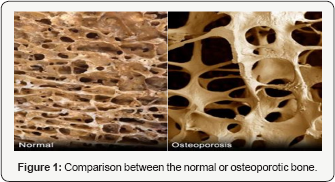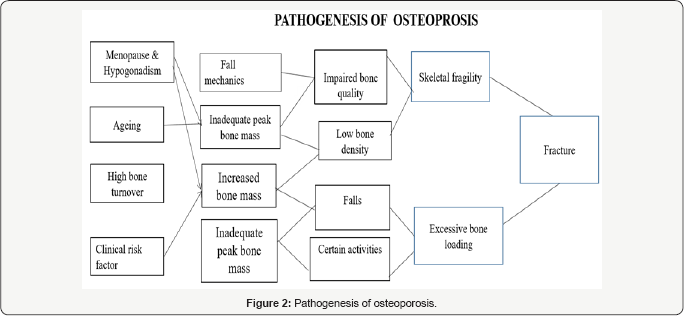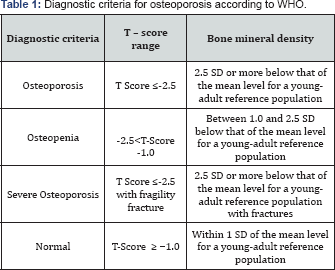Overview of Osteoporosis
*Priyanka kumari, Amoldeep and Neetu
M.M Institute of Nursing, Indi
Submission: March 20, 2017; Published: March 30, 2017
*Corresponding author: Priyanka kumari, Assistant Professor, M.M Institute of nursing, Maharishi Markandeshwer University Mullana, Ambala, India, Email: priyankakumari@mmumullana.org
How to cite this article: Priyanka k, Amoldeep, Neetu. Overview of Osteoporosis. Ortho & Rheum Open Access 2017; 5(5): 555673. DOI: 10.19080/OROAJ.2017.05.555673
Abstract
Osteoporosis is one of main basis offracture and age associated disease, more common in women than men. Multifactorial factor are responsible for the pathogenesis of osteoporosis. Decrease of bone mineral density lead to risk factor of osteopenia. For the diagnosis of osteoporosis bone mineral density test is helpful to measure the bone strength. Radiography and dual energy X - ray help to identify the fracture assessment. The mini overview of article provide the etiology, clinical manifestation, pathogenesis, treatment and prevention of osteoporosis.
Objective
Osteoporosis means porous bones, causes bones to become weak and brittle associated with age. The aim of this review is to describe the overview regarding the identification and management of osteoporosis.
Introduction
Osteoporosis one of the major cause for the fracture among aged and adult population. Osteoporosis causes bone to become porous and so brittle that even mild alteration in posture may lead to fracture. Osteoporosis is skeletal disorder which affect the more than 10 million Americans [1]. Osteoporotic fracture are more oftenly reported in women i.e. 40% to 50% and 13 % in men [2,3]. However other study reported that the occurrence of fracture was similar in men and women [4]. The clinical consequences of osteoporosis can lead to osteopenia (decrease in bone density mineral). In normal young female bone mineral density ranges between 1 to 2.5 standard deviations of T score is considered as osteopenia. In Postmenopausal women, T-score <-1.0 are considered asosteoporosis and are also at increased risk of spine, lumbar vertebrae, hip, and wrist fracture. Fragility fractures of ribs are also common in men. Nonetheless, the above-mention diagnostic criteria is used forwomen as well as men [5]. Two categories of osteoporosis have been identified: primary and secondary. Primary osteoporosis is more common in females. In primary osteoporosis, postmenopausal osteoporosis generally develop after menopause because of drop in estrogen levels. Senile osteoporosis generally occurs at the age of 70 years in which thinning of bone occurred. Senile osteoporosis is degenerative osteoporosis because of wear and tear on the bones. Secondary osteoporosis is less common as it is caused by certain medical condition or treatment, which affect the bone mass and cause bone loss [6] (Figure 1).

Osteoporosis associated with fracture as characterized by less bone mass, porous bone and structural deterioration [2]. Mainrisk factor for osteoporosis are exhibited by age and sex. Risk appears to be increased during childhood and adolescent period where as risk get decreases in mature life because of peak bone mass. But after the age of 45 year particularly in women risk again increased while in men are risk generate above the age of 60 [7,8]. Genetic factors also play an important role in variation to bone density. A lifelong lack of calcium, estrogen, vitamin -D intake and increased consumption of alcohol and nicotine plays a major role for the occurrence of osteoporosis. Long term use of certain drugs like prednisone, dexamethasone, methotrexate, heparin can cause severe damage to bones and ultimately lead to bone loss. Some endocrine and gastrointestinal disorders also contribute for the risk of osteoporosis [9]. Lack of physical activity is also one of the risk factor for osteoporosis and lower incidence of fracture is seen among rural and hilly communities because of effect of habitual exercise [10].
Pathophysiology
Remodeling of bone take place throughout the life for adaption of skeletal to mechanical changes. Bone remodeling cycle starts with degradation with osteoclast cell of old bone. Osteoblast cells synthesize the bone matrix. Osteoporosis is an imbalance between the activity of osteoblast and osteoclast cell.This imbalance will lead to bone degradation [11]. Decrease process of osteoblastogenesis can lead to spontaneous fracture in old age [12]. In osteoclast generation mainly two cytokines are essential and adequate that are macro phase colony stimulating factor (M -CSF) and receptor activator of nuclear factor kappa B ligand (RANKL). Bone marrow stromal cells and osteoblast are mainly responsible for releasing this two essential cytokines [13]. EphrinB2 is expressed by osteoclast where as ephrinB4 expressed by osteoblast, interact with each other so that osteoclast activity can be limited and osteoblast differentiation can be promoted [14] (Figure 2).

Clinical Manifestation
Osteoporosis has no any symptoms itself but the increased risk of bone fractures [15]. Patient with osteoporosis report dull pain, tenderness, stiffness, swelling, kyphosis, loss of height and vasomotor disturbances. Osteoporotic fractures occur in such situations where healthy people would not normally break a bone; they are therefore regarded as fragility fractures. Typical fragility fractures occur in the vertebral column, rib, hip and wrist. Bending and lifting increases the risk of vertebral fractures [16]. Pelvis, hip, femur, vertebral, humorous, forearm are commonly occurring fractures in osteoporosis. Vertebral strength is more decreased in women than men [17,18].
Diagnosis
Diagnosis of osteoporosis can be made by measuring bone mineral density and radiotherapy [19]. Bone mineral density testhelps to find out the bone strength [20]. Dual energy X-ray absorptiometry help to detect the bone mineral density with total body composition and fat content [21]. Other method used for the detection of osteoporosis is fracture assessment, ultrasound densitometer [22]. Computed tomography and peripheral dual energy X- ray absorptiometry [23]. Bone mineral density is reported as T score. It is expressed negative term. Diagnostic criteriafor osteoporosis according to WHO is following (Table 1).

Treatment
Calcium and vitamin D supplementation is considered to be effective treatment for osteoporosis [24]. In Pharmacology treatment aminobisphosphonates (zoledronic acid, alendronate, risedronate) are effective against both vertebral and non vertebral fractures. In addition to this hormone replacement therapies has been widely used for post menopausal women including raloxifene (selective estrogen receptor modulator)that preserve skeletal micro architecture , moderately increasing the bone mass and ultimately reduce the risk for fracture [25,26]. Kyphoplasty/ Vertebroplasty are conducted in the management of the vertebral compression fracture.It is a minimal invasive procedure that is effective for minimizing pain but along with this, complication rates are high as it may increase the incidence of new fracture of adjacent vertebras [27]. Hip protectors are used to reduce the risk of hip fracture to increase the thickness of soft tissue though trochanteric padding. This system is designed in such a way that it reduces the predicted peak force on the trochanter by absorbing the impact on hip while falling [28,29].
Prevention
Adequate intake of calcium is essential for maintenance of bone density and functioning of muscles. Primary and secondary prevention of osteoporosis include supplementation of calcium and vitamin D. Vitamin-D helps to enhance the absorption of serum calcium in small intestine. Weight bearing and non weight bearing exercise are effective in osteoporosis prevention. These exercises improve the posture, balance, liveliness and strength to prevent falls [29,30]. For reducing risk of spine fractures, combination exercise programs were found to be more effective. Osteoporosis related morbidities can be reduced by hearing and vision corrections, and removing fall hazards [31].
References
- National Osteoporosis Foundation (2002) America's bone health: The state of osteoporosis and low bone mass in our nation. Washington, DC: The Foundation 1-55.
- Johnell O, Kanis J (2005) Epidemiology of osteoporotic fractures. Osteoporos Int 16: S3-S7.
- O'Neill TW, Felsenberg D, Varlow J, Cooper C, Kanis JA, et al. (1996) The prevalence of vertebral deformity in European men andwomen: the European vertebral osteoporosis study. J Bone Miner Res 11(7): 1010-1018.
- Jackson SA, Tenenhouse A, Robertson L (2000) Vertebral fracture definition from population-based data: preliminary Results from the Canadian multicenter osteoporosis study. Osteoporos Int 11(8): 680687.
- World Health Organization (1994) Study Group. Assessment of fracture risk and its application to screening for postmenopausal osteoporosis. Report Geneva, Switzerland.
- Riggs BL, Melton LJ (1983) Evidence for two distinct syndromes of involution osteoporosis. Am J Med 75(6): 899-901.
- Garraway WM, Stauffer RN, Kurland LT, Fallon WM (1979) Limb fractures in a defined population. Frequency and distribution. Mayo Clin. Proc 54(11): 701-707.
- Kanies JK, Pitt FA (1992) epidemiology of osteoporosis US National Library of Medicine National Institutes of Health 13: 7-15.
- Peter p, Martin R (2015) osteoporosis an age related and gender specific disease US National Library of Medicine National Institutes of Health 62:128-137.
- Wickham C, Walsh K, Cooper C, Barker DJ, Margetts BM, et.al. (1989) Dietary calcium, physical activity and risk of hip fracture: a prospective study. Br Med J 299: 889-892.
- Bergman RJ, Gazit D, Kahn AJ, Gruber H, McDougall S, et al. (1996) Age-related changes in osteogenic stem cells in mice. J Bone Miner Res 11(5): 568-577.
- Jilka RL, Weinstein RS, Takahashi K, Parfitt AM, Manolagas SC (1996) Linkage of decreased bone mass with impaired osteoblastogenesis in a murine model of accelerated senescence. J Clin Invest 97(7): 17321740.
- Rauner M, Sipos W, Pietschmann P (2007) Osteoimmunology. Int Arch Allergy Immunol 143(1): 31-48.
- Mundy GR, Elefteriou F (2006) Boning up on ephrin signaling. Cell 126(3): 441-443.
- Willson T, Nelson SD, Newbold J, Nelso, RE, LaFleur J (2015) "The clinical epidemiology of male osteoporosis: a review of the recent literature.” Clinical epidemiology 7: 65-76.
- Iskrant A P, Smith R W (1969) Osteoporosis in women 45 years and over related to subsequent fractures . Public Health Rep 84: 33-38.
- Yun TJ, Chaudhary PM, Shu GL, Frazer JK, Ewings MK, et al. (1998) OPG/FDCR-1, a TNF receptor family member, is expressed in lymphoid cells and is up-regulated by ligating CD40. J Immunol161(11): 61136121.
- Li Y, Toraldo G, Li A, Yang X, Zhang H, Qian WP, et al. (2007) B cells and T cells are critical for the preservation of bone homeostasis and attainment of peak bone mass in vivo. Blood 109(9): 3839-3848.
- Guglielmi G, Scalzo G (2010) Imaging tools transform diagnosis of osteoporosis”. Diagnostic Imaging Europe 26: 7-11.
- Johnell O, Kanis J (2005) Epidemiology of osteoporotic fractures. Osteoporos Int 16: S3-S7.
- World Health Organization (2007) WHO Scientific Group on the assessment of osteoporosis at primary health care level: Summary meeting report, Geneva, Switzerland: 1-17.
- McCloskey EV, Vasireddy S (2008) Vertebral fracture assessment (VFA) with a densitometer predicts future fractures in elderly women unselected for osteoporosis. J Bone Miner Res 23(10): 1561-1568.
- National Osteoporosis Foundation (2002) America's bone health: The state of osteoporosis and low bone mass in our nation. Washington, DC: The Foundation 1-55.
- Titanji K, Vunnava A, Sheth AN, Delille C, Lennox JL (2014) Dysregulated B cell expression of RANKL and OPG correlates with loss of bone mineral density in HIV infection. PLoSPathog10(11): e1004497.
- Lennox JL, Sanford SE, Foster A, Knezevic A, Easley KA, et al. (2014) Dysregulated B cell expression of RANKL and OPG correlates with loss of bone mineral density in HIV infection. PLoSPathog10: e1004497.
- Emontiero O, Vidal C, Duque G (2012) Aging and bone loss: new insights for the clinician. Ther Adv Musculoskelet Dis 4(2): 61-76.
- Dong XN, Qin A, Xu J, Wang X (2011) In situ accumulation of advanced glycation endproducts (AGEs) in bone matrix and its correlationwith osteoclastic bone resorption. Bone 49(2): 174-183.
- Breuil V, Ticchioni M, Testa J, Roux CH, Ferrari P, et al. (2010) Immune changes in postmenopausal osteoporosis: the Immunos study. OsteoporosInt21(5): 805-814.
- Tobon GJ, Izquierdo JH, Canas CA (2013) B lymphocytes: development, tolerance, and their role in autoimmunity-focus on systemic lupus erythematosus. Autoimmune Dis 827254.
- National Osteoporosis Foundation (2010) Clinician's guide to prevention and treatment of osteoporosis. Washington, DC. National Osteoporosis Foundation 1-56
- Standing Committee on the Scientific Evaluation of Dietary Reference Intakes (1997) Dietary reference intakes for calcium, phosphorus, magnesium, vitamin D, and fluoride. Washington, DC. National Academy of Sciences, USA.






























